
The Ish Shel Lechem Bakery will go on a short summer break next week, August 20-25. You can increase your bread order for the week via our Order System, or contact us and we’ll update the order for you. Enjoy!
____________________________________________
It’s been such a hot week. While we complain and sweat and drink and try to cool ourselves off, there are actually those who are elated by the heat and humidity. One of them is the star of this week’s Newsletter!
At this very time, our eggplants are making their debut at Chubeza (to stay with us till autumn), as the sweltering outdoor temperatures remind them of their birthplace: Southern India and Sri Lanka. The eggplant first migrated from India to Burma and then China. In ancient Chinese writings, eggplants are mentioned as early as the fifth century. From there, they continued onto the Middle East, where they remain a prominent ingredient in the local cuisine to this very day. The Muslim Moors of North Africa who conquered Spain in the eighth century brought eggplants with them to Southern Europe, while the Italians made their acquaintance with the exotic vegetable via commercial ties with Arab merchants in the 13th century.
The eggplant, so adored in Israeli cuisine, is one of the vegetables grown in hothouses during the cold season in order to maintain a constant supply to its Israeli aficionados. At Chubeza, we bid it farewell in winter and delightfully welcome its return with the great heat of summer.
The eggplant is considered a long, annual or biannual crop. Years ago, during a visit to Iris Ben-Zvi, a veteran organic grower in the Jezreel Valley, we learned of a method in which eggplant seedlings are left in the field over the winter. At the close of the harvest, the plants are pruned and simply left in place to pass the winter in a type of dormancy. When spring arrives, the confused eggplants yield once again. We did give this method a try, but it yielded smaller, lower-quality eggplants. We thus prefer to simply replant the crop each year.
We plant eggplants at Chubeza when winter is already turning to spring, right at the end of March, when the zucchini and pumpkins have already been growing in the field for a month or more. This is when the first eggplant seedlings begin to acclimate in the ground, youthful and sleek with silky leaves. About a month and a half later, at the start of May, we plant the second round.
The plants grow happily, strong and healthy, and grace us with lovely purple flowers that start peeking out of the leaves some two months after being planted.
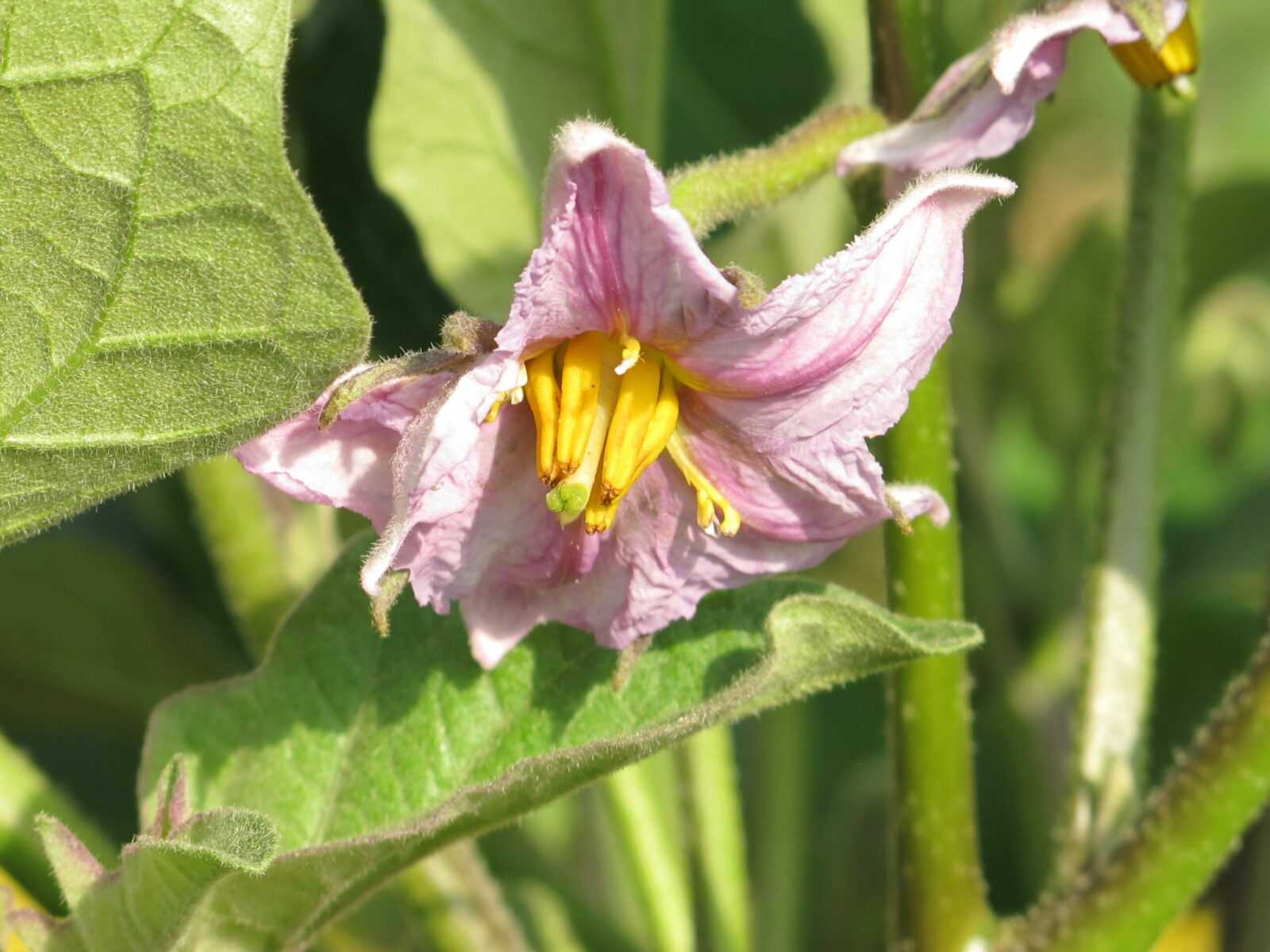
Within a few weeks, the flowers are fertilized and they grow chubby dark fruits. That is when we harvest. We prefer to pick the eggplants at a medium size, not waiting for huge fruits that have passed their climax.
To determine if the eggplant is ready, we measure it, but also apply slight pressure to check its softness. An unripe fruit will be hard and unresponsive to fingertip pressure. A ripe fruit is more flexible, but firm.
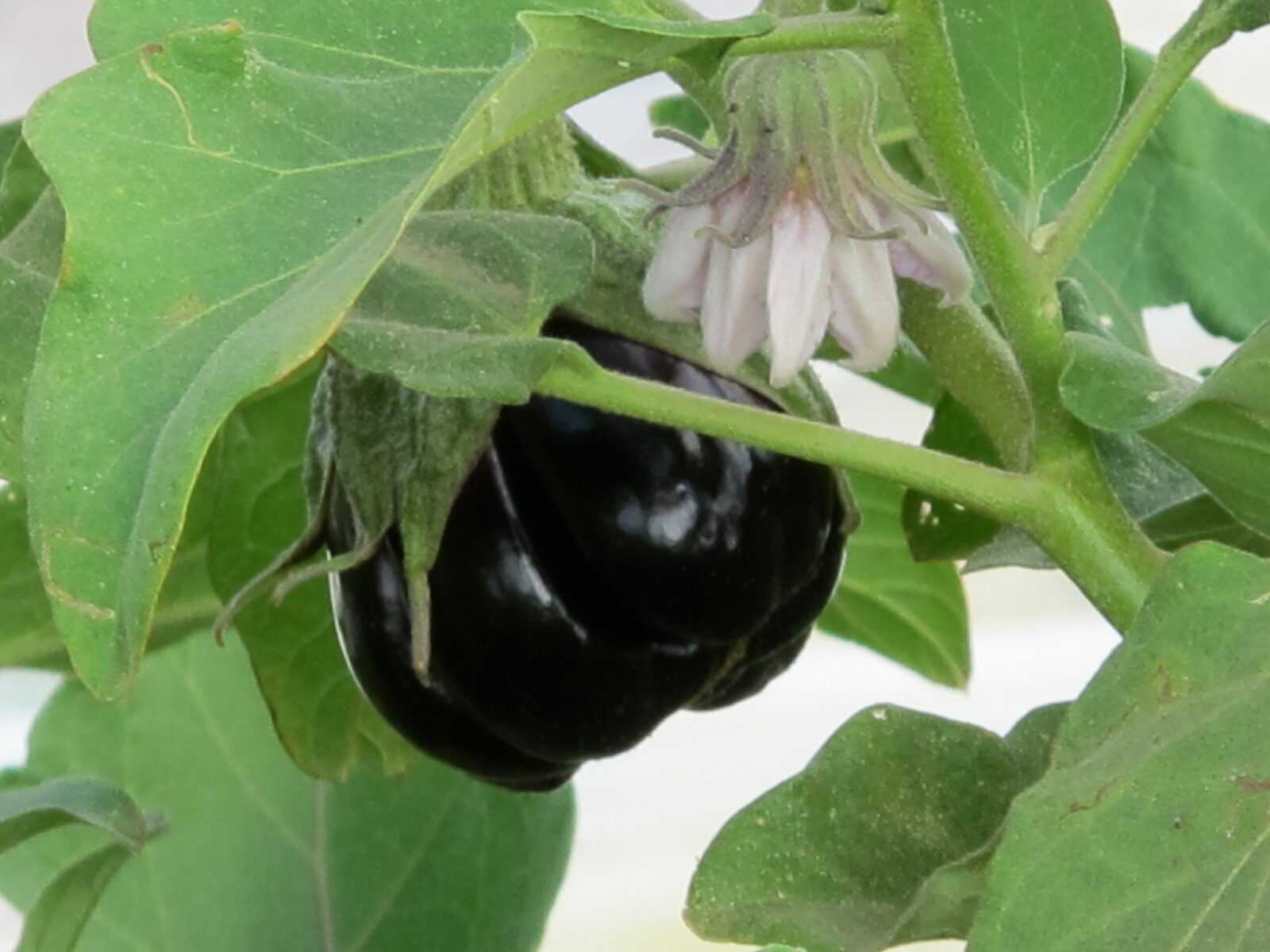
The eggplant is an androgynous plant, meaning every flower is both female and male. The flowers usually ripen themselves, but sometimes they get by with a little help from a friendly fly-by insect:
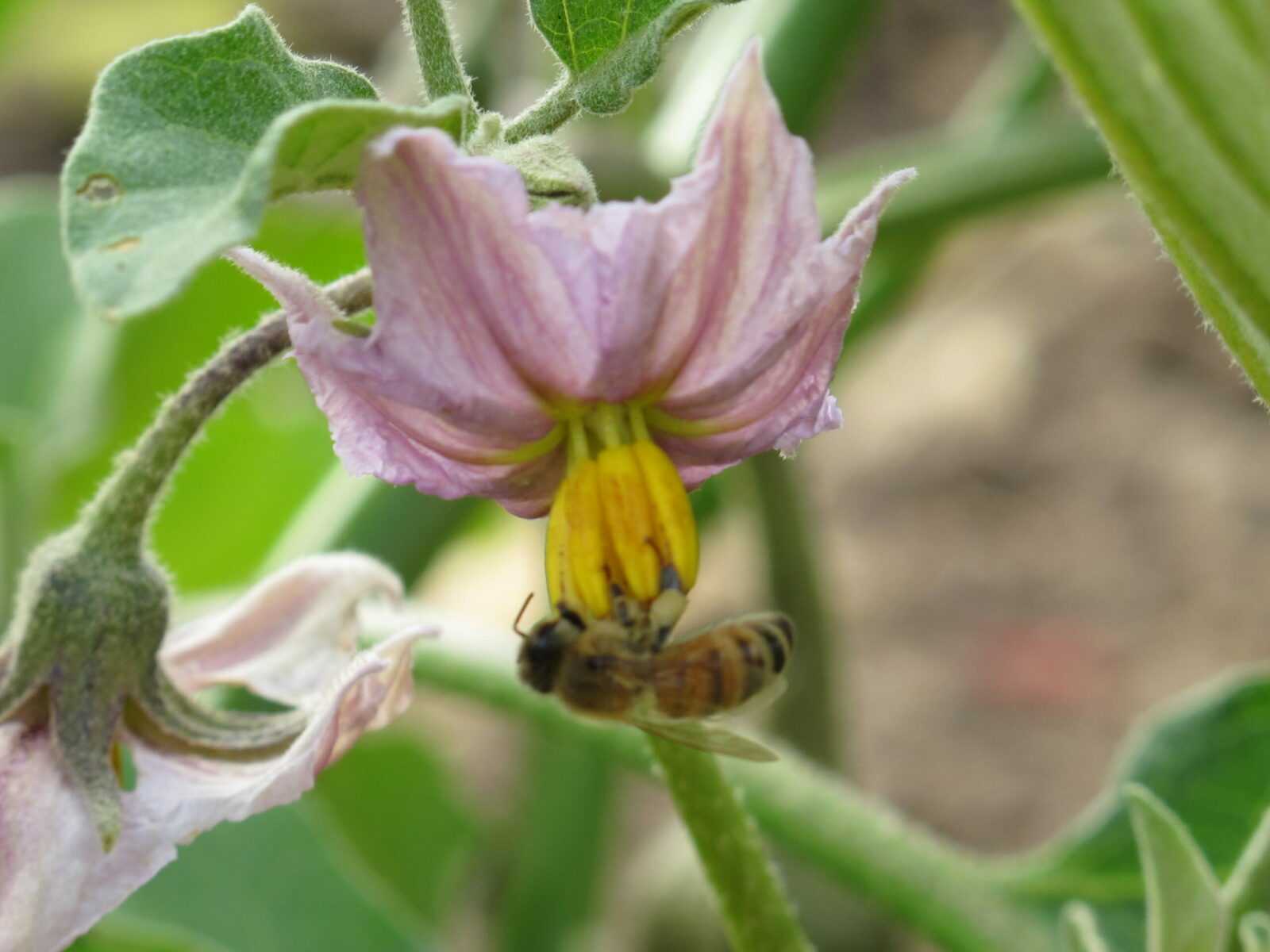
And here I’m duty-bound to refute the Number One Urban Legend: there is no such thing as a male (fewer seeds, less bitter) and female (more seeds, more bitter) eggplant. The difference in seed quantity is due to spraying with plant hormones (Auxin) in order to prevent the leaves and flowers from falling, particularly during the cold months. (It goes without saying that in organic agriculture and in Chubeza’s fields, no such sprays are to be found…)
Eggplants arrived in Israel long before the Hebrew pioneers, for, as noted, this vegetable was – and still is – an important component in the Arabic cuisine. The concept of meshing the eggplant to the charcoal grill certainly reached this area around the time the wheel was invented…
But the eggplant also held a place of honor in the Zionist kitchen of the nascent State of Israel. During the era of austerity after the State was established, eggplant recipes were invented and designed to take full advantage of this vegetable’s three most admirable characteristics: availability, low price and an amazing ability to absorb flavors. In Israel’s early days, the eggplant was used as a convenient replacement for the real thing. Liver is expensive? Let’s just liver-flavor the eggplant. Tomatoes sky-high in price? Just blend one tomato with ten eggplants, and voila: a tomato-flavored eggplant! There is even a dessert dish: sugar-coated eggplant, baked like a strudel, which periodically makes its way onto Israeli restaurant menus. And alongside these wonder foods, the eggplant has always starred in Mideast cuisine as a component in various salads, and as round and fried to eventually become, in Israeli culinary jargon… antipasti!
There are those who proclaim the eggplant as king of the local vegetables, but with or without a royal title, it is definitely a guest of honor in the emerging Israeli kitchen and one of the most deeply-rooted homegrown representatives of this area.
The first crucial exam for basic essentials in the local kitchen is the Long-Term Adaptability Test, i.e., will this food appear over the years in simple and popular recipes alongside the “gourmet” recipes of prosperous times? The eggplant passes this test with flying colors: from a range of eggplant salads to popular fast-food—the sabich—to high-falutin’ roasted eggplant with tahini goose liver, eggplant with tuna tartar, creamed eggplant, eggplant jam, and more.
Its Hebrew name is also quite ancient, renewed over a century ago by Avraham Moshe Lunz, a writer, publisher, journalist, Land of Israel researcher, and member of the prestigious Hebrew Language Committee. In 1897, Lunz corrected the name of the common vegetable to chatzil, based on the rare Arabic word chitzal. (Today, eggplant’s accepted name in Arabic is badanjan).
There are many types of eggplants in the world, in various shapes and hues. In Israel we are mainly acquainted with the big dark-purple elliptic type, but eggplants also come in green, brown, yellow, elongated, round, small and large varieties. The name “eggplant” belies the fact that the fruits of some 18th-century European cultivars were white, small and elliptical, resembling eggs hanging on a bush. (This hen is for illustrative purposes only. Trust us, real eggplants grow on bushes.):
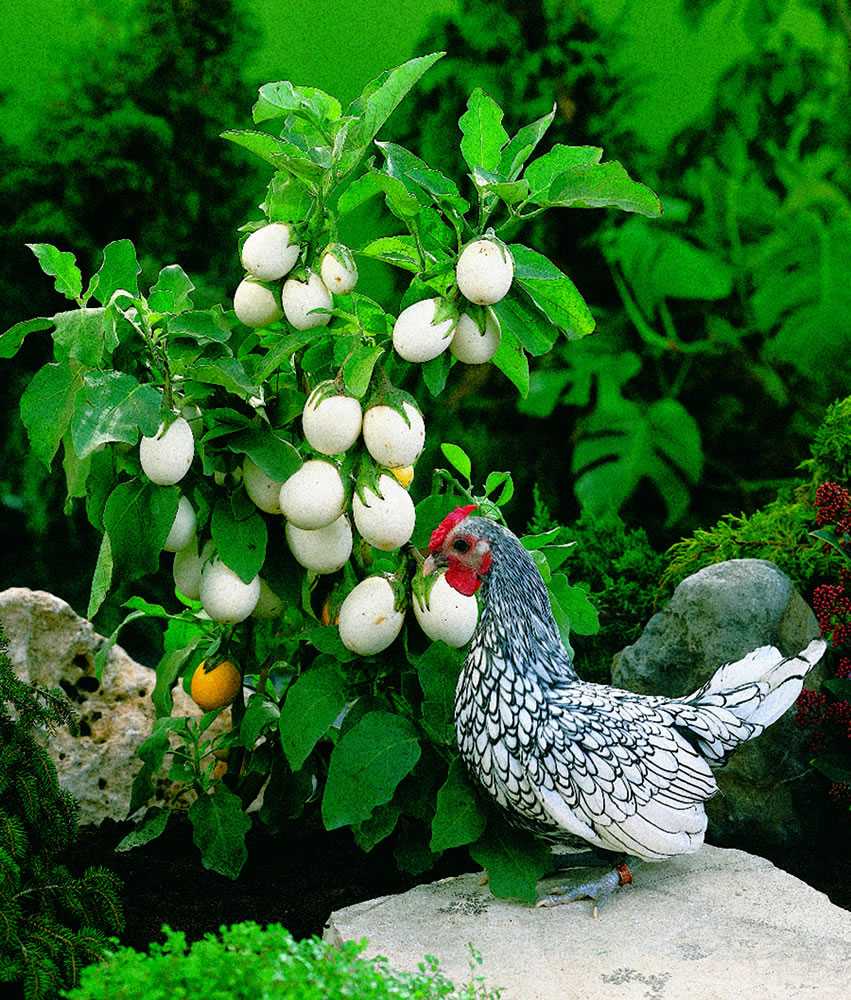
This year, we grew several eggplant varieties in our field – the well-known “Barba-abba,” a variety of local homegrown eggplant which so far has yielded huge, round fruit (don’t panic, it’s not because they were picked too late. They’re young and fresh and nice, and just… big), and a third variety of light purple “finger” eggplants. Here is a group pose of the three:
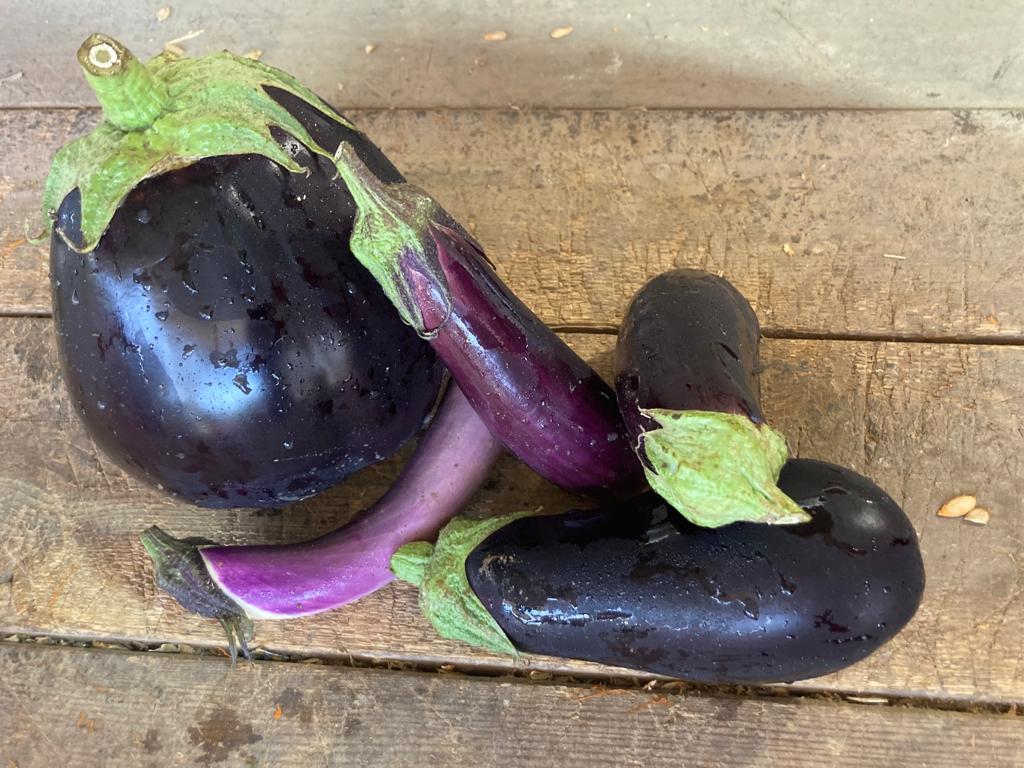
The first eggplants, being Solanaceae family members, were treated with utmost suspicion by the Europeans. The Solanaceaes include a wide assortment of such plants as the tomato, pepper, potato, plus other plants which include varieties so toxic that they are fatal. Due to this familial affiliation, most all members were suspected of being poisonous. Even today, there are those (for example, followers of the macrobiotic diet) who avoid eating Solanaceae family veggies. These harmful substances are found to a much lesser degree in the eggplant, thus making it harmless for most everyone. The toxic substances are primarily found in the eggplant’s leaves and stem. However, at the start of the eggplant’s journey, Solanaceae phobia forced the eggplant to be grown in Europe solely as an ornamental plant, with its large leaves, impressive structure and lush purple flowers contributing sheer joy to gardeners.
Today, the eggplant is renowned for its medicinal and nutritional value. It boasts elements which shrink blood vessels, thus beneficial for treating hemorrhoids and bleeding wounds. Eggplants promote secretion of liver and gall bile and are advantageous for anemia, constipation, stomach ulcers and infections of the large intestine. The eggplant contains antioxidants that can help prevent strokes and bleeding, and the phytochemical monoterpene which promotes prevention of heart disease and cancer. Researchers have been examining the eggplant’s possible influences on battling cancer by reducing the steroid hormones which encourage the development of tumors, and preventing the oxidization of cells that lead to cancer’s spread. A folk cure for scorpion bites is a slice of raw eggplant applied directly to the sting, and to relieve frostbite, eggplant tea is chilled to room temperature and its soothing compresses placed over the burn.
But the best use of the eggplant is for food: eat it steamed, toasted, baked (if fried, use only a little oil, because its sponge-like texture absorbs large quantities of oil), grilled, chopped and diced, stuffed, sliced or cubed. Your dependable peacemaker, it goes nicely with cheeses or meat, tahini or tomatoes, but also does quite well on its own with just coarse salt, lemon juice and parsley. Bon Appétit!

May everyone survive these sweltering days in the shade, drinking up, and having great fun in the pool or at the seashore (or in an air-conditioned room). Just remember: even the endless August heat is only temporary. Autumn is out there now, waiting in the wings…
Alon, Bat-Ami, Dror, Orin and the Chubeza team
___________________________________________________
WHAT’S IN THIS WEEK’S BOXES?
Monday: Cherry tomatoes/onions, lettuce, parsley/coriander, eggplants of various varieties: regular/baladi/finger eggplants, edamame/Thai lubia beans, slice of pumpkin/bell peppers, potatoes, corn, tomatoes, cucumbers, Amaro Kabocha squash/butternut squash.
Large box, in addition: Scallions, okra, sweet potatoes.
FRUIT BOXES: Nectarines, Gala apples, mangos, plums. Large box: Larger quantities of all of the above, plus pears.
Wednesday: Lettuce, corn, cherry tomatoes/edamame, Amaro Kabocha squash/Spaghetti squash, sweet potato, eggplants of various varieties: regular/baladi/finger eggplants/onions, cucumbers, tomatoes, Thai yard-long beans, coriander/parsley, slice of pumpkin/butternut squash/okra.
Large box, in addition: Potato, bell peppers, scallions.
FRUIT BOXES: Nectarines, Gala apples, mango, pears/plums (only the small box). Large box: Larger quantities of Nectarines, Gala apples, mango and peachs.
